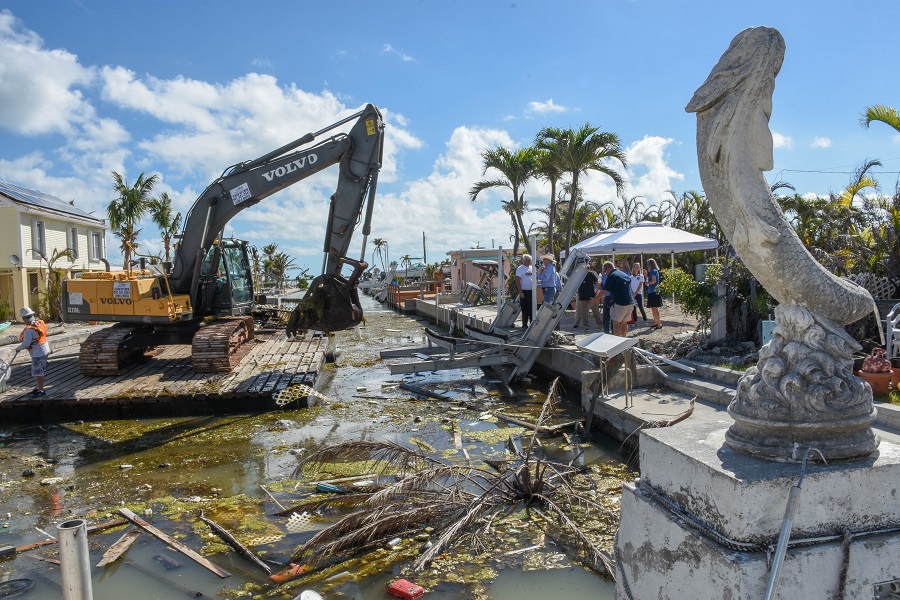Hurricane Irma Marine Debris Cleanup Begins in Monroe County

Working from a crane anchored on top of a barge on Friday morning, an operator used a knuckleboom loader to remove toppled trees, destroyed fencing, roofing material and even a TV from canal #290 along Avenue I on Big Pine Key.
This was the beginning of a 12- to 18-month process to remove hurricane debris from the impacted canals and nearshore waters of the Florida Keys.
“Watching this work begin to clean up our precious waters is great to see,” Monroe County Mayor David Rice said following a news conference to explain the removal project. “The County is working with the Florida Department of Environmental Protection and others on the project that isn’t easy, but that is critical to our environment and our economy. We are working to remove all navigation hazards, and to restore the canals and nearshore waters so our residents, visitors and wildlife can enjoy them again.”
Last week, Monroe County signed an agreement with DEP to assist in the marine debris removal effort of the impacted canals and nearshore waters of Monroe County. DEP hired DRC Environmental Services to do the work. DEP will oversee the $6 million operation with Monroe County, and Monroe County staff will provide local coordination.
“The Department of Environmental Protection is proud to partner with Monroe County with this unprecedented and complex effort to remove storm debris from impacted canals and nearshore waters,” said Gus Rios, DEP Branch Manager. “This effort is important to restore navigation safety and for the protection of the unique marine resources of the Florida Keys.”
DEP anticipates additional funding commitments of $2 million each with the City of Marathon and the Village of Islamorada.
Monroe County and the municipalities will reimburse DEP within the next 24 months. The County then will seek reimbursement from FEMA for the allowable 75 percent of the cost.
FEMA, the Florida Division of Emergency Management, the Florida Fish and Wildlife Conservation Commission, the U.S. Coast Guard, the U.S. Environmental Protection Agency, the Florida Keys National Marine Sanctuary and Monroe County’s consultant AMEC Foster Wheeler also helped with the planning efforts.
There are 513 canals throughout the Keys. It is estimated that they all were impacted to some degree: 97 high impact, 150 medium impact, 139 lower impact and 127 low impact. Of those 513 canals, 333 are in unincorporated Monroe County.
Based on aerial photos, there is an estimated 100,000 cubic yards of marine hurricane debris that needs to be removed from Keys’ waters at a total removal cost of $15 to $30 million. The numbers could go higher once actual debris amounts are known.
Monroe County is seeking additional funding sources to complete the marine debris cleanup.
This $6 million, first-phase operations is expected to take 4-6 months to complete. The canals and nearshore waters in this phase are being prioritized by level of impact and economic impact to the residents. The hardest hit areas will be cleaned first.
Canal #290 was one of the six canals that had been restored as part of the County’s canal restoration demonstration projects, using muck removal and the installation of an air curtain to keep out floating vegetation.
The debris that is collected will be taken by barge to a temporary off-loading site. It won’t stay at this location long before being hauled by trucks to the Debris Management Site at the former Big Pine Key Prison site. From there, it will be sorted and prepared for hauling to a permitted solid waste disposal facility approved by DEP on the mainland.
For this project, the debris being removed includes vegetation, hazardous waste, construction and demolition debris, propane tanks, appliances, electronic waste, docks, vehicles, seawalls and houses or portions of houses that pose a direct threat to the health, safety and welfare of the residents of the County and the State of Florida.
It does include motorhomes. It does not include boats, which are being addressed through the displaced vessel removal effort being overseen by the FWC. Also, no sediment or silt will be removed under this phase because it is not reimbursable by FEMA.
The work is being done with an operational plan approved and permitted by DEP and NOAA that ensures the protection of wildlife.


Facebook Comments